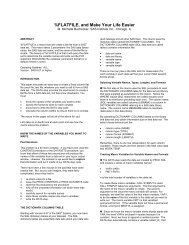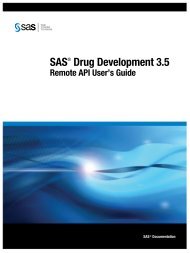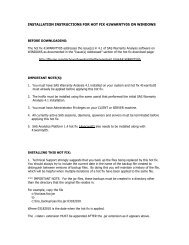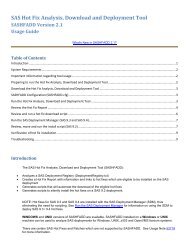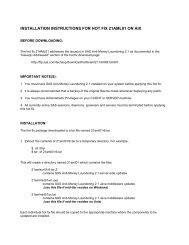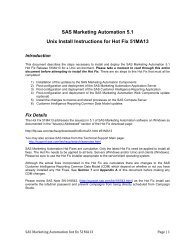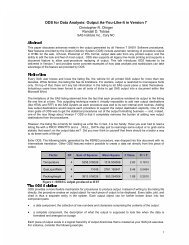TS-DOC: TS-678 -SAS V9 Object Spawner - Ftp Sas
TS-DOC: TS-678 -SAS V9 Object Spawner - Ftp Sas
TS-DOC: TS-678 -SAS V9 Object Spawner - Ftp Sas
You also want an ePaper? Increase the reach of your titles
YUMPU automatically turns print PDFs into web optimized ePapers that Google loves.
<strong>SAS</strong> Technical Support Document <strong>TS</strong>-<strong>678</strong><br />
Installing the <strong>SAS</strong> 9.0<br />
<strong>Object</strong> <strong>Spawner</strong><br />
for <strong>SAS</strong> 8.2 Servers on OS/390 and z/OS Platforms<br />
Lindy Mayfield<br />
October 2003<br />
<strong>SAS</strong>/Europe Customer Support<br />
Lindy.mayfield@eur.sas.com<br />
1
Table of Contents<br />
Installing and Running the <strong>SAS</strong> 9.0 <strong>Object</strong> <strong>Spawner</strong> ..................................................... 3<br />
Introduction........................................................................................................... 3<br />
Installing the <strong>SAS</strong>/ IT 9.0 <strong>Spawner</strong> for use with <strong>SAS</strong> 8.2 IOM.................................... 4<br />
Overview............................................................................................................ 4<br />
Installing Version 9 <strong>Object</strong> <strong>Spawner</strong> Load Modules from Hotfix ............................... 5<br />
Installing New <strong>SAS</strong> 8.2 <strong>SAS</strong>WQS Module from Hotfix.............................................. 5<br />
Security Considerations ....................................................................................... 5<br />
Setting up the <strong>Object</strong> <strong>Spawner</strong> Started Task.......................................................... 6<br />
Setting up the <strong>Object</strong> <strong>Spawner</strong> to run under USS................................................... 7<br />
Creating and configuring the object spawner configuration file................................ 9<br />
Creating and configuring the object spawner shell script .......................................10<br />
Creating the <strong>SAS</strong> IOM Server CLIST.....................................................................12<br />
Starting the <strong>Object</strong> <strong>Spawner</strong> ...............................................................................13<br />
Testing the operator connection to the <strong>Object</strong> <strong>Spawner</strong> ........................................14<br />
Testing the connection via the EG Administrator ...................................................14<br />
2
Installing and Running the <strong>SAS</strong> 9.0 <strong>Object</strong> <strong>Spawner</strong><br />
Introduction<br />
In order to facilitate the move away from APPC and towards the technology used by <strong>SAS</strong><br />
9, a hotfix has been created for <strong>SAS</strong> 8.2 to allow the <strong>SAS</strong> 8.2 IOM Server to be started by<br />
the <strong>SAS</strong> 9.0 <strong>Object</strong> <strong>Spawner</strong>.<br />
In order to run the <strong>SAS</strong> 9.0 <strong>Object</strong> <strong>Spawner</strong>, a full <strong>SAS</strong> 9.0 installation is not necessary.<br />
A hotfix has been created that contains a small subset of the <strong>SAS</strong> 9.0 software which<br />
contains only the modules required to run the object spawner.<br />
A bit of a technical description of how things work may be in order. Here is a brief<br />
comparison between the old and the new setup. The old way worked very well: The<br />
object spawner is started and listens to a port. The client connects to that port and<br />
supplies credentials. Once validated, the spawner uses APPC services to launch <strong>SAS</strong> in an<br />
APPC address space. The spawner gives the client socket to the IOM server and the IOM<br />
server takes it. The client and server are now connected with the server running in an<br />
APPC address space.<br />
The new way works like this: The object spawner is started and listens to a port, just like<br />
always. The client connects to that port and is validated. Next, the spawner spawns the<br />
command supplied in the configuration file, which is a shell script that will launch <strong>SAS</strong> with<br />
the proper parameters. Since the object spawner uses the spawn service, it can easily<br />
pass the socket from the client to the server.<br />
3
Installing the <strong>SAS</strong>/ IT 9.0 <strong>Spawner</strong> for use with <strong>SAS</strong> 8.2 IOM<br />
Overview<br />
The Version 9 <strong>Object</strong> <strong>Spawner</strong> can launch either an <strong>SAS</strong> 8.2 or <strong>SAS</strong> 9 IOM server.<br />
Implementing the Version 9 <strong>Object</strong> <strong>Spawner</strong> with the <strong>SAS</strong> 8.2 IOM Server will consist of<br />
the following actions, and each will be covered in detail.<br />
o Install Version 9 <strong>Object</strong> <strong>Spawner</strong> Load Modules from Hotfix<br />
o Install New <strong>SAS</strong> 8.2 <strong>SAS</strong>WQS Module from Hotfix<br />
o Security considerations<br />
o Setting up the <strong>Object</strong> <strong>Spawner</strong> Started Task<br />
o Setting up the <strong>Object</strong> <strong>Spawner</strong> to run under USS<br />
o Creating and configuring the object spawner configuration file<br />
o Creating and configuring the object spawner shell script<br />
o Creating the <strong>SAS</strong> IOM Server CLIST<br />
o Starting the <strong>Object</strong> <strong>Spawner</strong><br />
o Testing the operator connection to the object spawner<br />
o Testing the connection via the EG Administrator<br />
Two things need to be done before starting the configuration of the object spawner:<br />
1. The customer must obtain the new <strong>V9</strong> <strong>Object</strong> <strong>Spawner</strong> modules from hotfix 82IH13.<br />
These modules must be installed into a separate load library and must be kept<br />
separate from the original <strong>SAS</strong> 8.2 install.<br />
2. A new <strong>SAS</strong> 8.2 <strong>SAS</strong>WQS module is needed for the <strong>SAS</strong> 8.2 IOM Server. This new<br />
module exists in the latest base <strong>SAS</strong> 8.2 hotfix bundle or can be obtained from hotfix<br />
82BB10. This is the only change to the 8.2 installation.<br />
For links to the hotfixes, see <strong>SAS</strong> Note SN-008715<br />
http://support.sas.com/techsup/unotes/SN/008/008715.html<br />
4
Installing Version 9 <strong>Object</strong> <strong>Spawner</strong> Load Modules from Hotfix<br />
Obtain hotfix 82IH13 which contains a small subset of <strong>SAS</strong> 9 load modules needed for<br />
executing the <strong>SAS</strong> 9.0 <strong>Object</strong> <strong>Spawner</strong>. The 82IH13 hotfix load library will only be used<br />
with the object spawner and not with the <strong>SAS</strong> 8.2 installation. The 82IH13 hotfix<br />
library must be kept separate from the <strong>SAS</strong> 8.2 library. Also provided in the<br />
82IH13 hotfix CNTL data set are several examples to aid in this setup.<br />
Note that an object spawner is a stand-alone <strong>SAS</strong> program that takes care of starting <strong>SAS</strong><br />
IOM servers. The object spawner can be a different release than the IOM server. The<br />
same object spawner can also launch IOM servers of different <strong>SAS</strong> levels (currently <strong>SAS</strong><br />
8.2, <strong>SAS</strong> 9.0, and <strong>SAS</strong> 9.1).<br />
Installing New <strong>SAS</strong> 8.2 <strong>SAS</strong>WQS Module from Hotfix<br />
Obtain the new <strong>SAS</strong>WQS module from hotfix 82BB10 or the latest base <strong>SAS</strong> 8.2 hotfix<br />
bundle. This new module will work with both APPC and UNIX System Services. The<br />
<strong>SAS</strong>WQS module belongs with the <strong>SAS</strong> 8.2 installation and should reside in either this<br />
hotfix load library or the <strong>SAS</strong> 8.2 prefix.LIBRARY. The <strong>SAS</strong>WQS module should be in a<br />
separate load library than the 82IH13 hotfix which contains supporting <strong>SAS</strong> 9.0<br />
modules. Take care not to mix these libraries. The new <strong>SAS</strong>WQS module must be in the<br />
search path of the CLIST that will start up the <strong>SAS</strong> IOM Server.<br />
Security Considerations<br />
IBM provides two levels of daemon security. The first is normal UNIX security whereby a<br />
daemon that switches the UID must run as superuser with a UID of 0, or the daemon<br />
must make a successful __passwd() call before a spawn() that will switch to that UID. In<br />
the case of the object spawner running under normal UNIX security, it is not necessary to<br />
run it with a superuser UID.<br />
If RACF Program control is enabled and the RACF facility class BPX.DAEMON is defined,<br />
then any program that makes a __passwd() call must run from a RACF program controlled<br />
library.<br />
For more information, please refer to the UNIX System Services Planning guide, especially<br />
the section entitled “Setting up for Daemons.”<br />
5
To begin the setup configuration, it is assumed that you have done the<br />
following:<br />
o You have a load library with the new <strong>SAS</strong> 9.0 spawner modules in it from hotfix<br />
82IH13. For purposes of this install document, I will call this library<br />
OBJSPAWN.<strong>V9</strong>.LOAD.<br />
o You have modified your 8.2 installation to use the new <strong>SAS</strong>WQS module from<br />
hotfix 82BB10 (or latest hotfix bundle).<br />
Setting up the <strong>Object</strong> <strong>Spawner</strong> Started Task<br />
There are three possible ways to run the <strong>Object</strong> <strong>Spawner</strong>:<br />
1. The <strong>Object</strong> <strong>Spawner</strong> can be run in an MVS address space as a STC, exactly as the 8.2<br />
<strong>Object</strong> <strong>Spawner</strong>. This is the preferred method.<br />
2. The <strong>SAS</strong> 9 <strong>Object</strong> <strong>Spawner</strong> can also run from a USS shell. There may be an<br />
advantage to this method in that a <strong>SAS</strong> administrator with no special MVS STC<br />
privileges can start, stop, and maintain the object spawner. This is a good method for<br />
testing or for preparing to run the object spawner from BPXBATCH.<br />
3. A variation of the USS shell method above is to run using BPXBATCH. This allows the<br />
object spawner to be started as an STC and at the same time run in a BPX address<br />
space. This method is used to overcome the PARM string’s 200 character limitation<br />
when running directly as a STC.<br />
Normally, you will choose to run the object spawner directly as a STC. This method is fine<br />
for using clients such as Enterprise Guide, Appdev Studio, or the Java interfaces. The<br />
<strong>Object</strong> <strong>Spawner</strong> reads its configuration file from a local text file in LDIF format.<br />
If you wish for the spawner to connect to an LDAP server in order to read the<br />
configuration information, then the problem of the object spawner parm string being<br />
longer than will fit into the MVS JCL Parm string of 100 characters must be dealt with. In<br />
9.0 the only workaround for this is to run the object spawner under the shell. At this<br />
point the object spawner can be started from the shell, for example running it in the<br />
background, or it can be run as a started task using BPXBATCH. The BPXBATCH method<br />
would be more suitable in a production environment.<br />
Therefore the recommendation would be to run the object spawner directly as an STC<br />
without LDAP, and as a STC using BPXBATCH if LDAP is used. Running the object<br />
spawner from the USS shell may be helpful for testing, for example in preparing for<br />
BPXBATCH.<br />
There are two restrictions when running in an MVS address space. The first is that<br />
SYSPRINT must be routed to an HFS file in order to ensure that any CLIST or other errors<br />
6
from the launch of the <strong>SAS</strong> IOM server are captured. The second restriction is that if the<br />
PARM string is longer than 100 characters, then the object spawner must be run in a USS<br />
shell. For this reason, if you are using LDAP then you cannot fit the parameters in the JCL<br />
PARM string, so you will have to run from the shell.<br />
If you are using an LDIF file and running the <strong>Object</strong> <strong>Spawner</strong> as a STC, a sample STC is<br />
provided in the 82IH13 hotfix CNTL data set called OBJSTC. If you are connecting to an<br />
LDAP server for the configuration information, please read the next section “Setting up<br />
the <strong>Object</strong> <strong>Spawner</strong> to run under USS” otherwise skip to the section “Creating and<br />
Configuring the <strong>Object</strong> <strong>Spawner</strong> Configuration File”.<br />
Setting up the <strong>Object</strong> <strong>Spawner</strong> to run under USS<br />
This step is optional and only necessary if you are using LDAP or you wish to run from the<br />
shell for testing purposes.<br />
First decide where you want to install the <strong>SAS</strong> <strong>Object</strong> <strong>Spawner</strong> files on USS. There is no<br />
need to install these in a public directory unless it is the intent that they be started by<br />
normal users. For purposes of this installation, I have chosen the arbitrary directory<br />
/objspawn9 and the name startobj.sh for the shell script that will invoke the object<br />
spawner.<br />
Create an external link to MVS.<br />
$ ln –e OBJSPAWN objspawn<br />
Next you need to let the system know the location of the MVS object spawner load<br />
modules. For purposes of demonstration, I have chosen the name OBJSPAWN.<strong>V9</strong>.LOAD.<br />
The load library is stored in the UNIX environment variable STEPLIB. The external link<br />
will search first the dataset named in STEPLIB and then go through the “normal” MVS<br />
search order, LPA, etc.<br />
$ export STEPLIB=’OBJSPAWN.<strong>V9</strong>.LOAD’<br />
If your <strong>SAS</strong>/C transient library is not in the linklist, then you must also create an<br />
environment variable for this.<br />
$ export ddn_CTRANS=<strong>SAS</strong>.<strong>SAS</strong>C.TRANSLIB<br />
Do not attempt to concatenate the <strong>SAS</strong>/C transient library in the STEPLIB. This will cause<br />
the object spawner to fail.<br />
7
Next put all of the following into a shell script, in our case called startobj.sh.<br />
#!/bin/sh<br />
export STEPLIB=OBJSPAWN.<strong>V9</strong>.LOAD<br />
exec /objspawn9/objspawn \<br />
-cf /objspawn9/objspawn.conf \<br />
-sv -slf /objspawn9/objspawn.log \<br />
> /objspawn9/bpxbat.log<br />
Verify that this shell script works properly. At this point you can either run the object<br />
spawner in the background or as a system STC using BPXBATCH.<br />
If this is to be run as an STC, then create the JCL to run BPXBATCH which will run the<br />
object spawner. The below JCL is provided in the 82IH13 hotfix CNTL dataset member<br />
USSSTC.<br />
//OBJSPAWN EXEC PGM=BPXBATCH,REGION=20M,<br />
// PARM='SH '<br />
//SYSPRINT DD SYSOUT=*<br />
//SYS<strong>TS</strong>PRT DD SYSOUT=*<br />
//SYSOUT DD SYSOUT=*<br />
//STDIN DD PATH='/objspawn9/startobj.sh'<br />
//STDOUT DD PATH='/tmp/objspawn9/bpxbat.stdout',<br />
// PATHMODE=(SIRUSR,SIWUSR,<br />
// SIRGRP,SIWGRP,SIROTH,SIWOTH),<br />
// PATHOP<strong>TS</strong>=(OWRONLY,OCREAT,OTRUNC)<br />
//STDERR DD PATH='/tmp/objspawn9/bpxbat.stderr',<br />
// PATHMODE=(SIRUSR,SIWUSR,<br />
// SIRGRP,SIWGRP,SIROTH,SIWOTH),<br />
// PATHOP<strong>TS</strong>=(OWRONLY,OCREAT,OTRUNC)<br />
Notes:<br />
o The STEPLIB environment variable in the shells script points to the <strong>Object</strong> <strong>Spawner</strong><br />
<strong>V9</strong> modules.<br />
o The environment variable ddn CTRANS points to the <strong>SAS</strong>/C transient library.<br />
o When you use this method to start the spawner, there is no longer the 100<br />
character limitation in the PARM statement.<br />
8
Creating and configuring the object spawner configuration file<br />
Creating the object spawner configuration file is similar to the V8 version of this file. For<br />
purposes of demonstration, I have chosen to call this file objspawn.conf.<br />
dn: sas<strong>Spawner</strong>cn=My<strong>Spawner</strong><br />
objectClass: sas<strong>Spawner</strong><br />
sas<strong>Spawner</strong>cn: My<strong>Spawner</strong><br />
sasMachineDNSName: localhost<br />
sasOperatorPort: 9902<br />
sasOperatorPassword: sas<br />
sasVerbose: true<br />
sasLogfile: /objspawn9/objspawn.log<br />
# This Server runs 8.2<br />
dn: sasServercn=MyServer82<br />
objectClass: sasServer<br />
sasPort: 9903<br />
sasProtocol: bridge<br />
sasCommand: /objspawn9/sas82.sh nosasuser --<br />
sasMachineDNSName: localhost<br />
sasServercn: MyServer82<br />
The PDS member OBJCFG in the 82IH13 hotfix CNTL data set is an example of this<br />
configuration file. In the sample configuration file you will need to change the ports, the<br />
location of the log file, and the location of the shell script (sasCommand).<br />
Notes:<br />
o The first block of text defines the object spawner.<br />
o The sasOperatorPort defines the port that you can telnet into to display a status of<br />
the spawner and shut it down.<br />
o The password will be used when you telnet to the spawner. Make it simple for<br />
testing, and then change it.<br />
o The remaining blocks of text, (here only one), define the servers that will be<br />
started when connecting to that particular port.<br />
o The sasCommand points to the shell script to launch <strong>SAS</strong>. This will be discussed in<br />
the next section.<br />
o Note the double dashes “--“ after the sasCommand. The following shell script uses<br />
this marker to separate the static from the dynamic parms passed to the IOM<br />
server.<br />
o Make sure the permission bits are set correctly for this file to be read. As an<br />
example, chmod 644 objspawn.conf.<br />
9
Creating and configuring the object spawner shell script<br />
A shell script is used to launch <strong>SAS</strong> in a UNIX System Services (BPX) address space. This<br />
shell script need only be modified to point to the CLIST to launch <strong>SAS</strong> as an IOM server.<br />
The IOM Server CLIST will be discussed next section. In the 82IH13 hotfix CNTL data set<br />
a sample shell script is provided called <strong>SAS</strong>82SH.<br />
#!/bin/sh<br />
#<br />
#-----------------------------------------------------------------<br />
# The following should be modified or verified<br />
#-----------------------------------------------------------------<br />
#<br />
# The following command should point to your <strong>SAS</strong> CLIST<br />
#<br />
cmd="/bin/tso -t EX '&sasprefix.CLIST(<strong>SAS</strong>82IOM)'"<br />
#<br />
#<br />
# The shell log contains the ouput from the /bin/tso command.<br />
#<br />
shlog="/tmp/inttech/shell.log"<br />
#<br />
# Use the account data to place <strong>SAS</strong> in the correct service class<br />
#<br />
# export _BPX_ACCT_DATA=A123<br />
#<br />
# Number of seconds before JWT timeout due to inactivity<br />
#<br />
# export TMOUT=30<br />
#<br />
# In case the <strong>SAS</strong> CLIST needs to call execs<br />
#<br />
# export SYSPROC="PROD.MVS.CLIST:USER.MVS.CLIST"<br />
#<br />
#<br />
#-----------------------------------------------------------------<br />
# No user modifications beyond this point<br />
#-----------------------------------------------------------------<br />
#<br />
#<br />
echo `date` "Starting an IOM Server. \n" >> $shlog<br />
#<br />
# foundDashDash is a boolean. When TRUE, we found the string<br />
# "--" in our arguments.<br />
#<br />
foundDashDash=0<br />
#<br />
# Construct our arguments<br />
#<br />
args=''<br />
for arg in "$@" ; do<br />
if [ "$arg" != "--" ]; then<br />
tmp="$arg ";<br />
else<br />
tmp="SRVOP<strong>TS</strong>(''";<br />
foundDashDash=1;<br />
fi<br />
args="$args$tmp"<br />
done<br />
#<br />
# If we found a "--", we need to close the SRVOP<strong>TS</strong> option<br />
#<br />
10
if [[ $foundDashDash -ne 0 ]]; then<br />
args="$args '')"<br />
fi<br />
#<br />
# Construct our command line...<br />
#<br />
cmd="$cmd '$args'"<br />
#<br />
echo `date` "Starting <strong>SAS</strong> with command:" $cmd "\n" >> $shlog<br />
#<br />
# Crank up <strong>SAS</strong><br />
#<br />
exec $cmd >> $shlog<br />
Notes:<br />
o Make sure that the permission bits are set correctly for this file. As an example,<br />
chmod 755 sas82.sh.<br />
o Take special note of the _BPX_ACCT_DATA environment variable. This may prove<br />
extremely valuable in tuning using WLM.<br />
o Note that the shell script’s output is directed to a file. This is valuable in<br />
debugging, and is necessary if this is run from MVS and BPXBATCH.<br />
o The line that reads cmd="/bin/tso -t EX '&sasprefix.CLIST(<strong>SAS</strong>82IOM)'" will<br />
need to point to the CLIST defined in the next section.<br />
11
Creating the <strong>SAS</strong> IOM Server CLIST<br />
A sample IOM Server CLIST is provided in the 82IH13 hotfix CNTL data set member called<br />
<strong>SAS</strong>82IOM. This CLIST differs from the CLIST provided with base <strong>SAS</strong> or other <strong>SAS</strong><br />
products. The IOM Server CLIST contains the NO<strong>SAS</strong>USER logic in it along with new<br />
CLIST parameters.<br />
Here are a few differences in the CLIST highlighted :<br />
STAI NOSTAI /* Trap subtask abends */ +<br />
STAX NOSTAX /* Trap attentions */ +<br />
STACK NOSTACK /* Create new i/p stack */ +<br />
SHARE NOSHARE /* Share subpool 78 */ +<br />
<strong>SAS</strong>CLIENTPORT() /* Client socket from spawner*/ +<br />
<strong>SAS</strong>DAEMONPORT() /* Port to connect to spawner*/ +<br />
SRVOP<strong>TS</strong>() /* for <strong>SAS</strong> IOM server */ +<br />
NETENCRALG() /* Encryption algorithm */ +<br />
INHERIT(0) /* Get socket from spawner */ +<br />
NO<strong>SAS</strong>USER /* Suppress <strong>SAS</strong>USER allocate */ +<br />
TCPDEBUG(0) /* TCPIP Debugging */ +<br />
TRACE /* CLIST debugging */<br />
The bottom lines of the CLIST should include the following logic:<br />
/*<br />
/* put system sort link library in STEPLIB if needed<br />
/*<br />
IF &STR(&SORTLINK) NE THEN +<br />
SET SORTLDSN=&STR()<br />
/*<br />
/*<br />
/* For IOM Server<br />
/*<br />
IF &STR(&SRVOP<strong>TS</strong>) NE THEN +<br />
SET OPTIONS=&STR(&OPTIONS &SRVOP<strong>TS</strong>)<br />
/*<br />
/* Invoke <strong>SAS</strong><br />
/*<br />
/*<br />
SET TASKLIB = &STR(&LOAD &<strong>SAS</strong>LOAD &SORTLDSN)<br />
SET PARM=&STR(T(&TASKLIB) E(&ENTRY) O('&OPTIONS') &FLUSH &NOFLUSH +<br />
&STAE &NOSTAE &STAI &NOSTAI &STAX &NOSTAX +<br />
&STACK &NOSTACK &SHARE &NOSHARE)<br />
<strong>SAS</strong>CP &PARM<br />
SET RC=&LASTCC<br />
CONTROL NOMSG<br />
IF &AUTOEXEC NE THEN +<br />
FREE F(&DDAUTOEX)<br />
EXIT CODE(&RC)<br />
12
Starting the <strong>Object</strong> <strong>Spawner</strong><br />
Starting the object spawner assumes that you have done the following:<br />
o You have installed the 2 necessary hotfixes<br />
o You have made the appropriate security changes necessary.<br />
o You have setup a method to start the <strong>Object</strong> <strong>Spawner</strong> (STC or shell)<br />
o You have created an object spawner configuration file.<br />
o You have created and customized the sas82.sh shell script to launch the <strong>SAS</strong> 8.2<br />
IOM Server.<br />
o You have verified, perhaps using PROC TCPTEST, that your TCP/IP environment is<br />
configured properly.<br />
Start the object spawner STC normally, or from the shell by launching the shell script<br />
startobj.sh.<br />
If the object spawner fails to start, check all log files for errors or other diagnostic<br />
information.<br />
13
Testing the operator connection to the <strong>Object</strong> <strong>Spawner</strong><br />
This is just a quick reality check to make sure that the object spawner is working ok.<br />
Telnet into the operator port of the object spawner; then type in the operator password.<br />
Enter the list command to see the available servers defined. Enter the bye command to<br />
shut down the spawner.<br />
Please note that the spawner does not echo characters typed back to the telnet session,<br />
and by default echo is not turned on with the telnet client that Microsoft provides.<br />
Testing the connection via the EG Administrator<br />
The very first tests should be with the EG Administrator. Begin by creating a new server<br />
and supplying the hostname and port of the IOM 8.2 server.<br />
When debugging, refer to all logs including the MVS syslog.<br />
14





